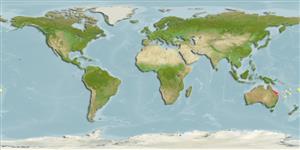Environment: milieu / climate zone / depth range / distribution range
Ökologie
seewasser riff-verbunden; standorttreu; tiefenbereich 2 - 40 m (Ref. 125611), usually 8 - 25 m (Ref. 125611). Subtropical; 12°S - 35°S
Western Pacific: restricted to eastern Australia, including Lord Howe Island.
Size / Gewicht / Alter
Maturity: Lm ? range ? - ? cm
Max length : 8.9 cm SL Männchen/unbestimmt; (Ref. 125611)
Rückenflossenstacheln (insgesamt) : 13; Rückenflossenweichstrahlen (insgesamt) : 11 - 13; Afterflossenstacheln: 2; Afterflossenweichstrahlen: 10 - 11.
Adults occur in small to large midwater aggregations on the outer edge of certain reefs in rich coralliferous areas in 5 to 25 meters. Juveniles and occasionally adults sometimes occur in lagoons (Ref. 7247). Oviparous, distinct pairing during breeding (Ref. 205). Eggs are demersal and adhere to the substrate (Ref. 205). Males guard and aerate the eggs (Ref. 205). Diurnal species (Ref. 54980; 113699).
Life cycle and mating behavior
Geschlechtsreife | Fortpflanzung | Ablaichen | Eier | Fecundity | Larven
Oviparous, distinct pairing during breeding (Ref. 205). Eggs are demersal and adhere to the substrate (Ref. 205). Males guard and aerate the eggs (Ref. 205).
Allen, G.R., 1991. Damselfishes of the world. Mergus Publishers, Melle, Germany. 271 p. (Ref. 7247)
IUCN Rote Liste Status (Ref. 130435: Version 2024-2)
Bedrohung für Menschen
Harmless
Nutzung durch Menschen
Tools
Zusatzinformationen
Download XML
Internet Quellen
Estimates based on models
Preferred temperature (Ref.
123201): 22.9 - 27.7, mean 25.9 °C (based on 345 cells).
Phylogenetic diversity index (Ref.
82804): PD
50 = 0.5000 [Uniqueness, from 0.5 = low to 2.0 = high].
Bayesian length-weight: a=0.01259 (0.00571 - 0.02773), b=3.03 (2.84 - 3.22), in cm total length, based on LWR estimates for this (Sub)family-body shape (Ref.
93245).
Trophic level (Ref.
69278): 2.7 ±0.29 se; based on food items.
Widerstandsfähigkeit (Ref.
120179): hoch, Verdopplung der Population dauert weniger als 15 Monate. (Preliminary K or Fecundity.).
Fishing Vulnerability (Ref.
59153): Low vulnerability (10 of 100).
Nutrients (Ref.
124155): Calcium = 96.3 [39.4, 197.8] mg/100g; Iron = 0.925 [0.510, 1.646] mg/100g; Protein = 19.2 [18.1, 20.3] %; Omega3 = 0.24 [0.13, 0.44] g/100g; Selenium = 9.6 [4.3, 20.7] μg/100g; VitaminA = 96.7 [28.4, 329.3] μg/100g; Zinc = 1.62 [1.01, 2.50] mg/100g (wet weight);
